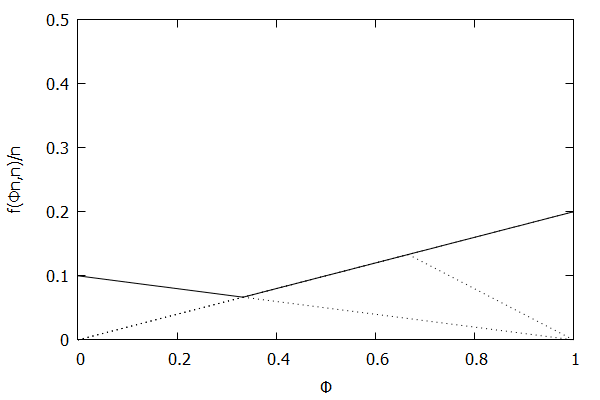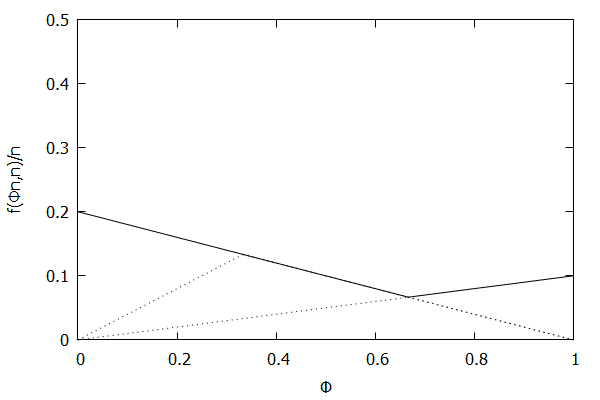
This is part 7/8 of my Calculating Percentiles on Streaming Data series.
In 2005, Graham Cormode, Flip Korn, S. Muthukrishnan, and Divesh Srivastava published a paper called Effective Computation of Biased Quantiles over Data Streams [CKMS05]. This paper took the Greenwald-Khanna algorithm [GK01] and made the following notable changes:
- Generalized the algorithm to work with arbitrary targeted quantiles, where a targeted quantile is a combination of a quantile $\phi$ and a maximum allowable error $\epsilon$. The algorithm will maintain the summary data structure $\mathsf{S}$ such that it will maintain each targeted quantile with the appropriate error rate.
- Simplified the
Compress()operation by removing the concept of banding.
The paper also demonstrated that the new, more generalized algorithm could handle the following cases with ease:
- The uniform quantile case, where each quantile is maintained with identical allowable error $\epsilon$.
- The low-biased quantile case, where lower quantiles (i.e. as $\phi$ approaches 0) are maintained with higher precision (lower maximum allowable error) than higher quantiles.
- The high-biased quantile case, where higher quantiles (i.e. as $\phi$ approaches 1) are maintained with higher precision (lower maximum allowable error) than lower quantiles.
Visualizing the Behavior of CKMS
Similar to my post about Visualizing Greenwald-Khanna, let’s visualize the above three cases with CKMS with $\epsilon = 0.1$.
Uniform Quantiles

Low-Biased Quantiles

High-Biased Quantiles

It’s quite visually intuitive how the low-biased quantiles case keeps more, finer-grained measurements at low percentile values, and the high-biased quantiles case keeps more, finer-grained measurements at high percentile values.
Understanding the CKMS Algorithm
Much of the below will only make sense if you have read the paper, so I suggest trying to read [CKMS05] first, and then returning here.
The key to understanding the CKMS algorithm is understanding the invariant function $f(r_i, n)$. I found that the best way to understand $f(r_i, n)$ is to understand the targeted quantiles invariant function (Definition 5 in [CKMS05]) and the error function $f(\phi n, n) / n$ charts (Figure 2 in [CKMS05]).
Uniform Quantiles Invariant Function
Consider the uniform quantile case, where we want all quantiles to be maintained with identical allowable error $\epsilon$. In this case, the targeted quantile tuples set will become $\mathsf{T} = {(\frac{1}{n}, \epsilon), (\frac{2}{n}, \epsilon), \ldots, (\frac{n-1}{n}, \epsilon), (1, \epsilon)}$.
Given the above definition, below is a visualization of the error function $f(\phi n)/n)$ computed for $\epsilon$ = 0.1 as $n$ increases from 3 to 10:

Visually, the solid polyline can be interpreted as the amount of error allowed at a given value of $\phi$; the higher the line, the more error allowed at that particular percentile.
Notice how the solid polyline is converging towards a horizontal line at $f(\phi n, n)/n = 0.2$, which exactly corresponds to the GK invariant function $f(r_i, n) = 2 \epsilon n$, as found in [GK01].
Low-Biased Quantiles Invariant Function
Now consider the low-biased quantile case, where we want lower quantiles to have higher precision than higher quantiles. In this case, the targeted quantile tuples set will become $\mathsf{T} = {(\frac{1}{n}, \frac{\epsilon}{n}), (\frac{2}{n}, \frac{2\epsilon}{n}), \ldots, (\frac{n-1}{n}, \frac{(n-1)\epsilon}{n}), (1, \epsilon)}$.
Given the above definition, below is a visualization of the error function $f(\phi n)/n)$ computed for $\epsilon$ = 0.1 as $n$ increases from 3 to 10:

Notice how the solid polyline allows less error at lower percentiles and is converging towards the line $f(\phi n, n)/n = 0.2\phi$, which exactly corresponds to the low-biased quantiles invariant function $f(r_i, n) = 2 \epsilon r_i$, as found in Definition 3 of [CKMS05].
High-Biased Quantiles Invariant Function
Now consider the high-biased quantile case, where we want higher quantiles to have higher precision than lower quantiles. In this case, the targeted quantile tuples set will become $\mathsf{T} = {(\frac{1}{n}, \epsilon), (\frac{2}{n}, \frac{(n-1)\epsilon}{n}), \ldots, (\frac{n-1}{n}, \frac{2\epsilon}{n}), (1, \frac{\epsilon}{n})}$.
Given the above definition, below is a visualization of the error function $f(\phi n)/n)$ computed for $\epsilon$ = 0.1 as $n$ increases from 3 to 10:

Notice how the solid polyline allows less error at higher percentiles and is converging towards the line $f(\phi n, n)/n = 0.2(1 – \phi)$, which corresponds to the high-biased quantiles invariant function $f(r_i, n) = 2 \epsilon (n – r_i)$ (not found in the [CKMS05] paper).
Availability in Streaming Percentiles Library
All four variants (uniform quantile, low-biased quantile, high-biased quantile, and targeted quantile) of the CKMS algorithm are available in my streaming percentiles library. Here’s an example of what it’s like to use:
|
|
Or, from JavaScript:
|
|
For more information, visit the streaming percentiles library GitHub page.
References
- [GK01] M. Greenwald and S. Khanna. Space-efficient online computation of quantile summaries. In Proceedings of ACM SIGMOD, pages 58–66, 2001.
- [CKMS05] G. Cormode, F. Korn, S. Muthukrishnan and D. Srivastava. Effective Computation of Biased Quantiles over Data Streams. In Proceedings of the 21st International Conference on Data Engineering, pages 20-31, 2005.